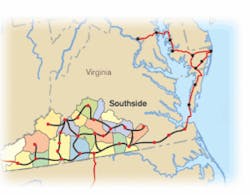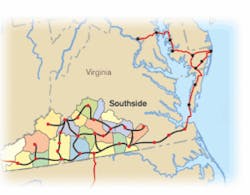Tobacco Commission lights up Virginia's Southside region
A 31-member group, the Tobacco Commission was established in 1999 by the state's General Assembly and chartered with overseeing the national tobacco settlement in Virginia. In late October, the Tobacco Commission issued a $3.35-million grant to the Mid-Atlantic Broadband Cooperative, a nonprofit entity formed to deploy broadband services such as high-speed Internet in Southside. The cooperative is responsible for managing the grant and installing the network. The U.S. Department of Commerce's Economic Development Administration (EDA) is matching the commission's grant with $3.35 million in federal funding. All the funding is for the first phase of the network, which will cover 142 mi, beginning in Patrick Country and ending in South Boston, the largest town in Halifax county. The fiber network will also serve Martinsville and Danville.
"This grant has been awarded with certain conditions that are being worked on, but they are mainly mechanical issues," says Carthan Currin, III, executive director of the Tobacco Commission (Richmond, VA). "One of the Tobacco Commission's major thrusts and one of our major challenges has been—not just in Virginia, but across the United States in the rural areas of our country—telecommunications access and cost have been a big hurdle to helping to foster a better climate for economic development."
"We've lost two million jobs in the last 10 years in manufacturing, and rural America is one of the areas where those manufacturers are pulling out," says David Hudgins, chairman of the Mid-Atlantic Broadband Cooperative's board of directors. "If we don't connect our communities and give them the opportunity to participate in this new service economy with this kind of deployment, then what is going to replace those manufacturers? And as China really gets fully integrated into the World Trade Organization, we see these manufacturers selecting that kind of option in order to compete in a global economy, and we see it accelerating, and so it is just becoming a necessity to connect our rural communities."
A key objective of the open access fiber network is to provide at least one alternative carrier to businesses in the region. To date, the incumbent local exchange carriers (ILECs)—Verizon Communications and Sprint—operate fiber routes to 24 of the 56 industrial parks in the Southside region. Other major providers such as Level(3) Communications and Williams have fiber in the area as part of their north and south networks, but they do not have fiber access points in the region that would allow other providers, schools, and public entities to connect to their networks.
A request for information (RFI) was issued by the Tobacco Commission in August, which advised respondents to "strongly consider" ITU-specified G.655 nonzero dispersion-shifted fiber for longer routes and G.652.C fiber for local access. Each cable must contain a minimum of 144 optical strands. The planned network is a DWDM-based infrastructure.
"If we are going to get more companies that are going to be global suppliers, then we need to address the fact that the industrial parks are wired and ready to do business globally," explains Tobacco Commission grants manager Tim Pfohl. "The thinking was, we've got 56 industrial parks across Southside, Virginia, and what can we do to make sure that those sites aren't crossed off of company-prospect lists? One of the great needs was redundant high-volume fiber capacity. If we can get all of these parks connected, then that lessens the chance greatly that they would be crossed off of prospect lists when companies are looking to locate. The RFI was sent out to test the waters from that standpoint, and the responses indicated, yes, it is feasible."
The Mid-Atlantic Broadband Cooperative subsequently issued a request for proposal (RFP) for network design and engineering services in the first week of November. Under the procurement rules of the EDA, the winner of that bid will then issue an RFP for construction.
The infrastructure will be operated as a wholesale open access fiber-optic network. "Whoever wants to buy services or dark fiber will only have to provide the card that goes into the box," says Hudgins. "What we are doing is leveling the playing field, where the interstate level and the toll are the same for everybody, and the local ISPs [Internet service providers] or the ILECs or CLECs [competitive local exchange carriers] compete on service and price."
The commission has been working with the local communities on this project for three years. In 2001, Virginia Polytechnic Institute and State University began to work with business and community officials to analyze how access to advanced technologies provided by optical networks could stimulate Virginia's economic development in a series of reports entitled "Strategic Technology Infrastructure for Regional Competitiveness in the Network Economy," as part of its eCorridors program. The report examined the telecommunications providers and placement of their fiber networks in the region and discussed a low-cost mesh-network design based on a financial model that could be duplicated in other rural areas of the United States.
"The commission reviewed the reports, and they kind of modeled the RFI on the open access network to deploy fiber into areas where it isn't currently available," says Hudnall Croasdall, a professor at Virginia Tech and assistant to the director of technology programs at the Tobacco Commission. "They are also planning to integrate some type of broadband wireless technology into the network, which for this region is very, very advanced."

